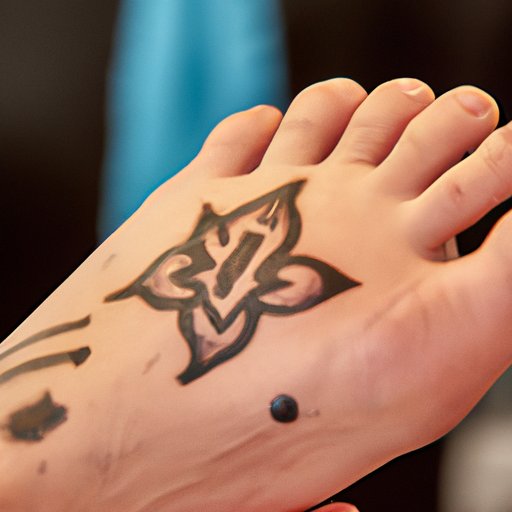
Introduction
Getting a new tattoo is an exciting and life-long commitment. Whether it symbolizes your individuality, love, or just passion, it’s something you want to take adequate care of to maintain its quality and beauty for a long, long time.
One of the questions many fresh tattoo lovers ask is when it’s safe to swim after getting a tattoo. While tattoos bear different meanings, it’s crucial to note that they are a type of open wound, and exposing them to churning waters can result in infections, damage, and discolorations. This article will provide you with a comprehensive guide on swimming safely after getting a tattoo.
Tattoo Aftercare: The Definitive Guide to Swimming Safely
Before diving into the specifics of swimming and tattoo care, it’s essential to first understand the basics of tattoo aftercare. Like any fresh wound, tattoos require an adequate healing process to ensure their longevity and quality. Below are some general tattoo aftercare tips:
- Follow the advice of the tattoo artist who creates your tattoo for the best aftercare recommendations.
- Wash your hands before touching your freshly tattooed skin.
- Keep your tattoo covered with a sterile bandage for the first few hours after getting inked.
- Avoid touching, picking, or scratching your tattooed skin.
- Avoid exposing your tattoo to direct sunlight or tanning beds.
- Avoid soaking your tattoo in pools, hot tubs, or the bathtub.
- Moisturize your tattoo regularly with a gentle, fragrance-free lotion.
As you can see, the guidelines for tattoo care generally discourage soaking and immersing your skin in water. This leads us to the question – when is it safe to swim after getting a tattoo?
Diving In: How Long Should You Wait Before Swimming After Getting Inked?
While fundamental guidelines on tattoo after-care recommend waiting a few days before soaking or immersing your tattoo in water, the process of tattoo healing isn’t that straightforward. Healing duration varies from person to person, depending on various factors, such as skin type, tattoo size, and structure. As such, it’s crucial to pay attention to your tattoo artist’s instructions and suggestions on when it’s safe to swim after getting inked. Factors that affect how long you need to wait include the size of the tattoo, which dictates how long it will take for it to heal fully, the depth that the needle penetrated the skin, which affects how long it will take for the skin to heal, and the area of the body in which the tattoo was placed.
As a general rule, it’s best to wait for at least two to four weeks or until the tattoo is entirely healed before swimming. For instance, a tattoo on the hand, wrist, ankle, or foot may take longer to heal than one placed on the upper arm or forearm.
Taking the Plunge: When to Take Your New Tattoo for a Swim
So, how can you tell when your tattoo is entirely healed and safe to swim? Here are some signs to look out for:
- The tattoo area shows no signs of redness, swelling, or itchiness.
- The scabs have fallen off naturally, and the skin has regained its suppleness
- The tattoo’s color is not faded or bleeding when you touch or rub it
Once you’re confident that your tattoo is fully healed and ready for a swim, you must take some precautions to avoid damage or infection.
- Shower before entering the pool or ocean to remove dirt and sweat that could harbor bacteria.
- Avoid staying in the water for too long; 30 minutes is the maximum recommended length for swimming with a new tattoo.
- Pat your tattoo dry with a clean towel – avoid rubbing it with the towel’s fabric to avoid unnecessary friction.
- Reapply a layer of sunscreen to protect your tattoo from further damage.
From Beaches to Pools: Navigating the Waters after a Tattoo
It’s essential to understand the differences between saltwater and chlorinated water when considering amenities to swim in after getting a tattoo. Saltwater is preferred by some because it is natural and poses no threat of bacteria, while chlorinated water has additives such as chemicals or other materials, which can be damaging to the skin.Taking a dip in a pool with chemicals may irritate your fresh tattoo, resulting in fading or discoloration.
Swimming in dirty water, including oceanic locales with unchecked bacterial levels, would be disastrous and extend the healing time or harm the fresh tattoo.
Ink and Water: Tips for Protecting Your Tattoo While Enjoying the Ocean or Pool
Tattoos, like skin, are vulnerable to sun damage from exposure to UV rays. Always use a broad-spectrum sunscreen to protect your skin, especially when swimming outdoors.
The American Academy of Dermatology recommends using a product with an SPF of 30 or higher and reapplying every two hours and immediately after swims, according to the package directions.
Finally, moisturize your tattoo after swimming to protect the colors and keep the skin smooth. Freshly inked skin will peel and flake as it heals, and dryness can exacerbate this condition. Use a fragrance-free lotion to minimize the peeling and itching.
Conclusion
Getting a new tattoo is a commitment that requires excellent after-care to turn out beautifully and maintain quality. As one of the questions that tattoo enthusiasts ask, it’s essential to note that waiting for your tattoo to heal entirely before diving in is the best practice. Heeding your tattoo artist’s advice and taking necessary precautions like following tattoo after-care guidelines, showering before swimming, and reapplying sunscreen can avert infections, bacterial transfer, and damage to your tattoo.
Remember, tattoos are unique, and proper aftercare differs for everyone. That said, take your time, ask questions, and treat your tattoo with care to ensure it stays beautiful for a very long time.





